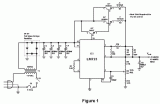Overview
Power supplies that are intended to be used with TTL logic circuitry must guard against over-voltage, which can destroy TTL chips very rapidly. The duration of over-voltage that can destroy TTL chips is much too brief to trigger any conventional fuse, so that only other semiconductor circuits can play any useful part in protecting a circuit against the type of failure of a stabilizer that leads to excessive voltage. As it happens, this is the most common type of stabilizer failure, so that the protection is necessary for any TTL circuit of any significance. Many modern digital circuits make extensive use of MOS devices, which are less susceptible to damage from over-voltage, but it is unusual to find a large digital circuit, which does not contain at least one or more TTL devices.
In the circuit shown below, if the voltage at the output terminals rises above 6.2V, zener conducts charging capacitor C4. This voltage will fire the silicon-controlled rectifier (SCR), which quickly shorts-or puts a ‘crowbar’ – across the supply rails blowing the fuse.
Circuit Description
The regulator IC is the familiar fixed voltage type such as LM7805. The 7805 is a three-pin regulator which requires a minimum voltage input of 7.5V to sustain stabilization, which an absolute maximum input voltage of 35V. The maximum load current is 1A and the regulation against input changes is typically 3-7mV for a variation of input between 7.1V and 25V. The regulation against load changes is of the order of 10mV for a change between 5mV and 1.5A load current. The noise voltage in the band from 10Hz to 100KHz is 40-50uV, and the ripple rejection is around 70db. Maximum junction temperature is 215 degrees C, and the thermal resistance from junction to case is 5 degrees C/W. This stabilizer is used extensively for power supplies in digital equipments.
In the circuit, the capacitors that are shown connected each side of the IC are very important for suppressing oscillations and must not be omitted. In particular, the 330nF capacitor at the input must be wired across the shortest possible path at the pins of the IC.
I chose a TIC 106A SCR because it can handle an anode current up to 4A at 100V, but has a very sensitive gate requiring only about 200uA to fire it. The SCR is only ‘on’ for a very short time and thus does not need a heat sink. If you use another type, it is not likely to display the same characteristics. Most SCR’s with a heavy anode current rating have insensitive gates. SCR’s with a lower anode current rating will need a heat sink.
The rating of fuse depends on the power supply you are using the circuit with. Assuming a maximum power supply output current of about 200 to 300 mA, you can fit a 500mA fuse.
The voltage at which the SCR switches on is largely dependent on the value of the zener. You can experiment with different values of zeners to protect other types of circuits. The 4000 series CMOS ICs have supply voltage limits of 15V (AE suffix) or 20V (BE suffix) and crowbar protection can be used for these too.
Author: Ravi Sumithraarachchi
Email: ravi@ualink.lk
Website: http://www.electronics-lab.com

 Audio
Audio







